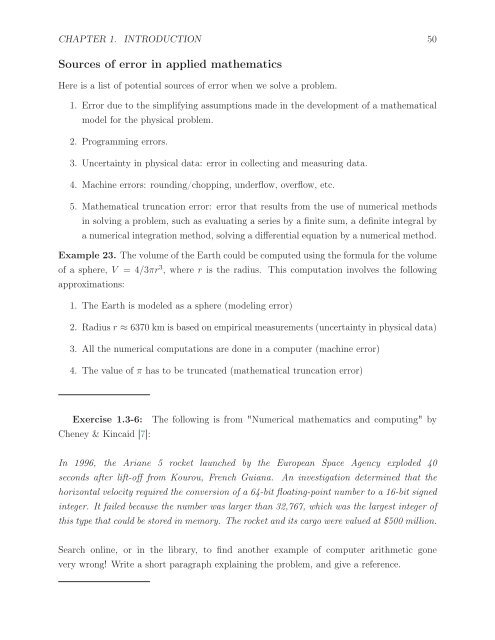First Semester in Numerical Analysis with Julia, 2020a
First Semester in Numerical Analysis with Julia, 2020a
First Semester in Numerical Analysis with Julia, 2020a
You also want an ePaper? Increase the reach of your titles
YUMPU automatically turns print PDFs into web optimized ePapers that Google loves.
CHAPTER 1. INTRODUCTION 50<br />
Sources of error <strong>in</strong> applied mathematics<br />
Here is a list of potential sources of error when we solve a problem.<br />
1. Error due to the simplify<strong>in</strong>g assumptions made <strong>in</strong> the development of a mathematical<br />
model for the physical problem.<br />
2. Programm<strong>in</strong>g errors.<br />
3. Uncerta<strong>in</strong>ty <strong>in</strong> physical data: error <strong>in</strong> collect<strong>in</strong>g and measur<strong>in</strong>g data.<br />
4. Mach<strong>in</strong>e errors: round<strong>in</strong>g/chopp<strong>in</strong>g, underflow, overflow, etc.<br />
5. Mathematical truncation error: error that results from the use of numerical methods<br />
<strong>in</strong> solv<strong>in</strong>g a problem, such as evaluat<strong>in</strong>g a series by a f<strong>in</strong>ite sum, a def<strong>in</strong>ite <strong>in</strong>tegral by<br />
a numerical <strong>in</strong>tegration method, solv<strong>in</strong>g a differential equation by a numerical method.<br />
Example 23. The volume of the Earth could be computed us<strong>in</strong>g the formula for the volume<br />
of a sphere, V =4/3πr 3 , where r is the radius. This computation <strong>in</strong>volves the follow<strong>in</strong>g<br />
approximations:<br />
1. The Earth is modeled as a sphere (model<strong>in</strong>g error)<br />
2. Radius r ≈ 6370 km is based on empirical measurements (uncerta<strong>in</strong>ty <strong>in</strong> physical data)<br />
3. All the numerical computations are done <strong>in</strong> a computer (mach<strong>in</strong>e error)<br />
4. The value of π has to be truncated (mathematical truncation error)<br />
Exercise 1.3-6: The follow<strong>in</strong>g is from "<strong>Numerical</strong> mathematics and comput<strong>in</strong>g" by<br />
Cheney & K<strong>in</strong>caid [7]:<br />
In 1996, the Ariane 5 rocket launched by the European Space Agency exploded 40<br />
seconds after lift-off from Kourou, French Guiana. An <strong>in</strong>vestigation determ<strong>in</strong>ed that the<br />
horizontal velocity required the conversion of a 64-bit float<strong>in</strong>g-po<strong>in</strong>t number to a 16-bit signed<br />
<strong>in</strong>teger. It failed because the number was larger than 32,767, which was the largest <strong>in</strong>teger of<br />
this type that could be stored <strong>in</strong> memory. The rocket and its cargo were valued at $500 million.<br />
Search onl<strong>in</strong>e, or <strong>in</strong> the library, to f<strong>in</strong>d another example of computer arithmetic gone<br />
very wrong! Write a short paragraph expla<strong>in</strong><strong>in</strong>g the problem, and give a reference.


















